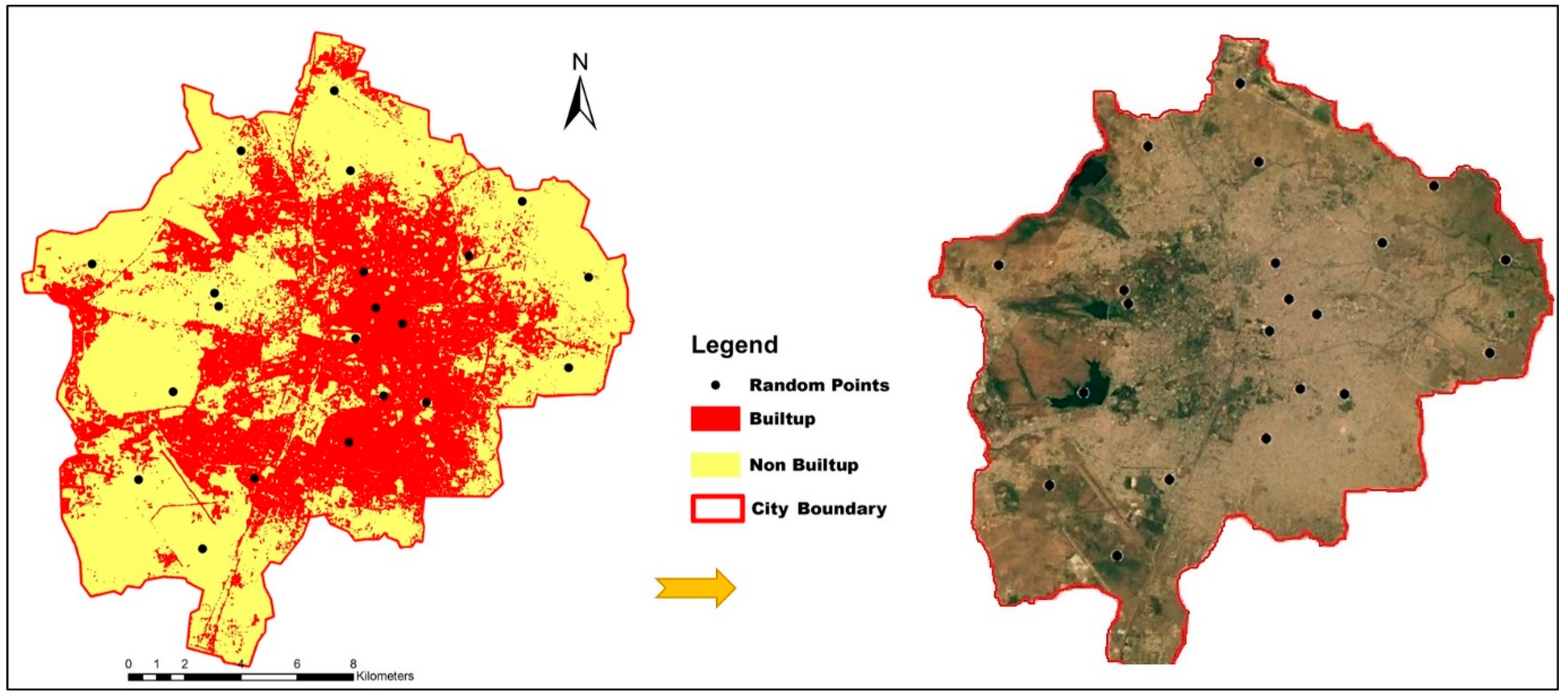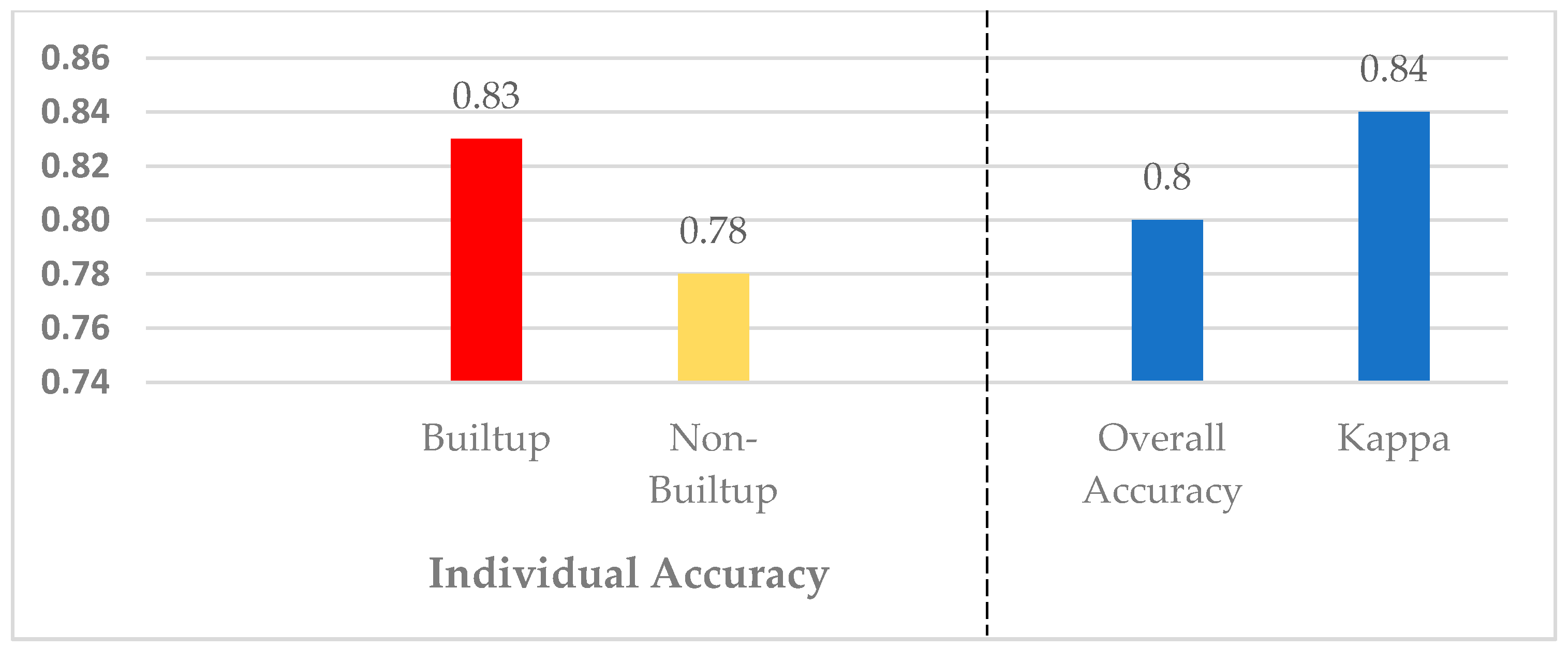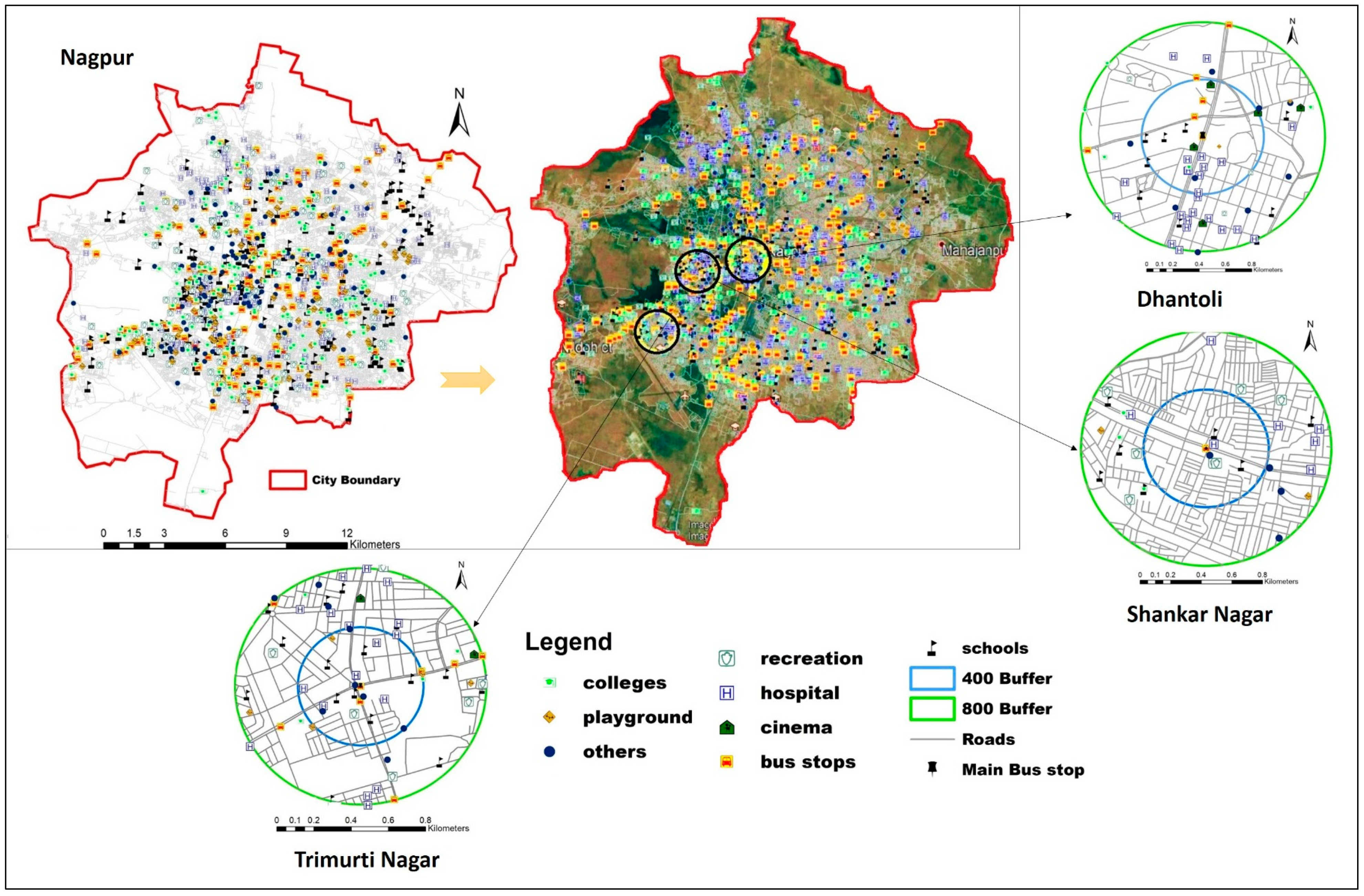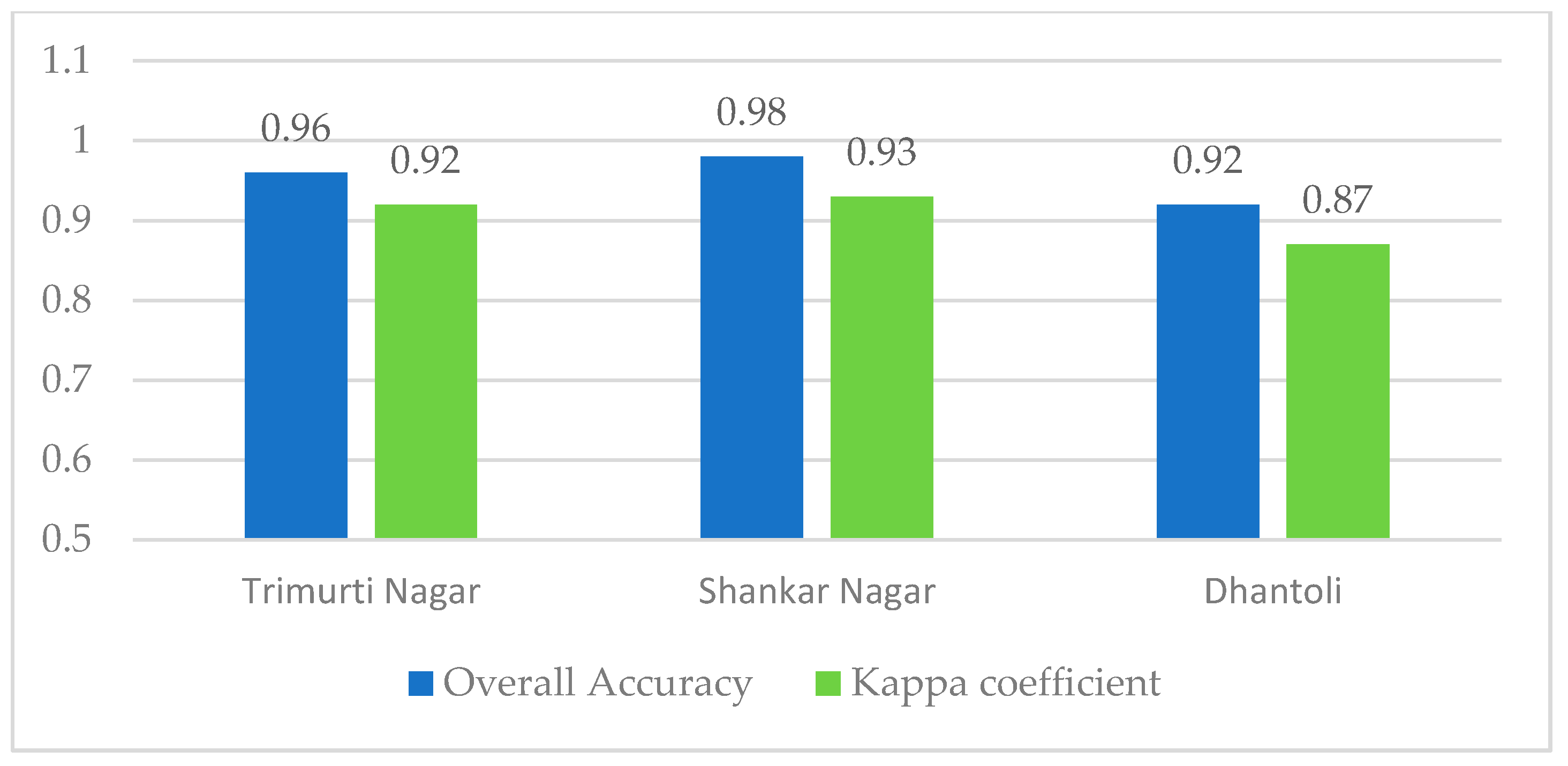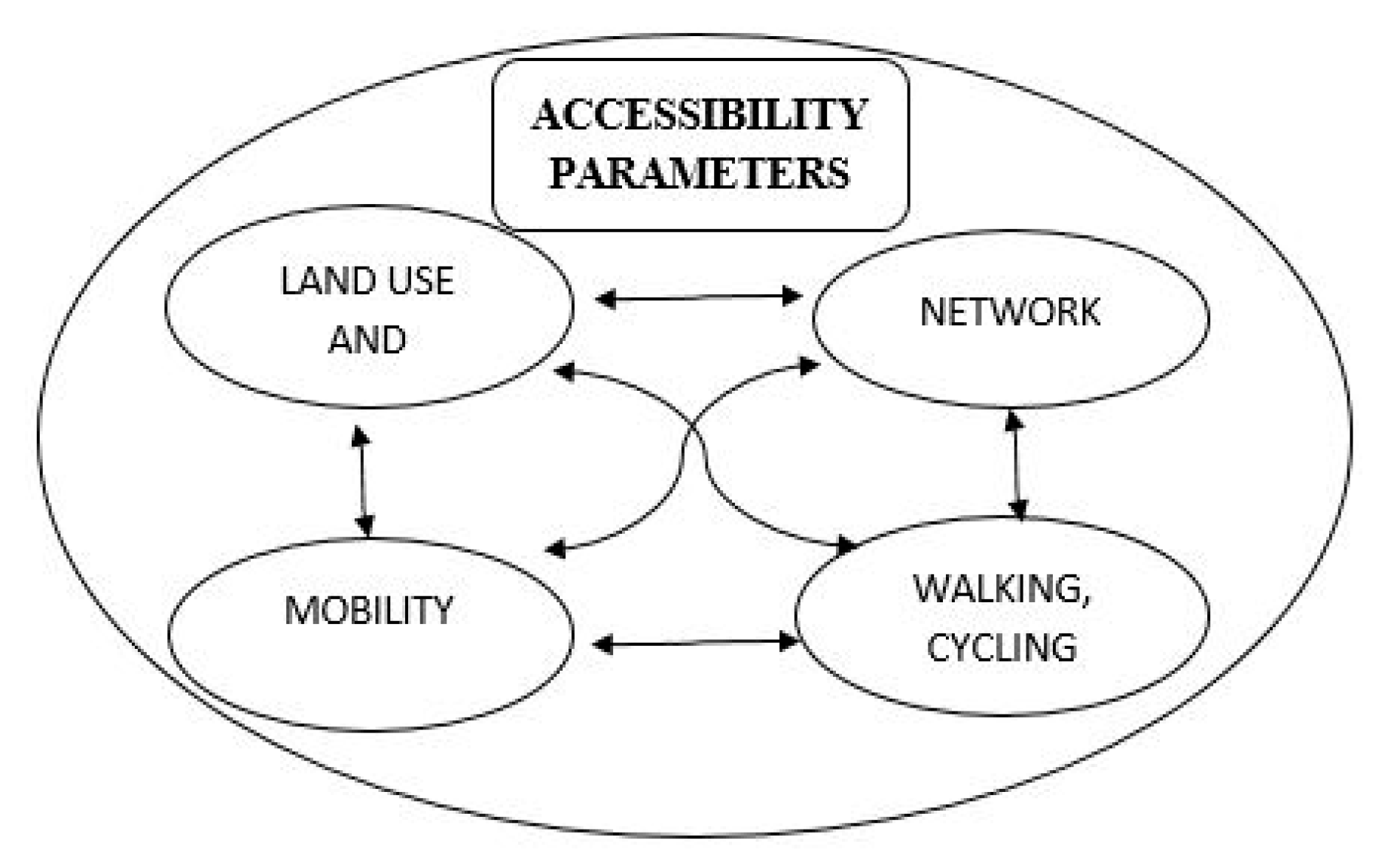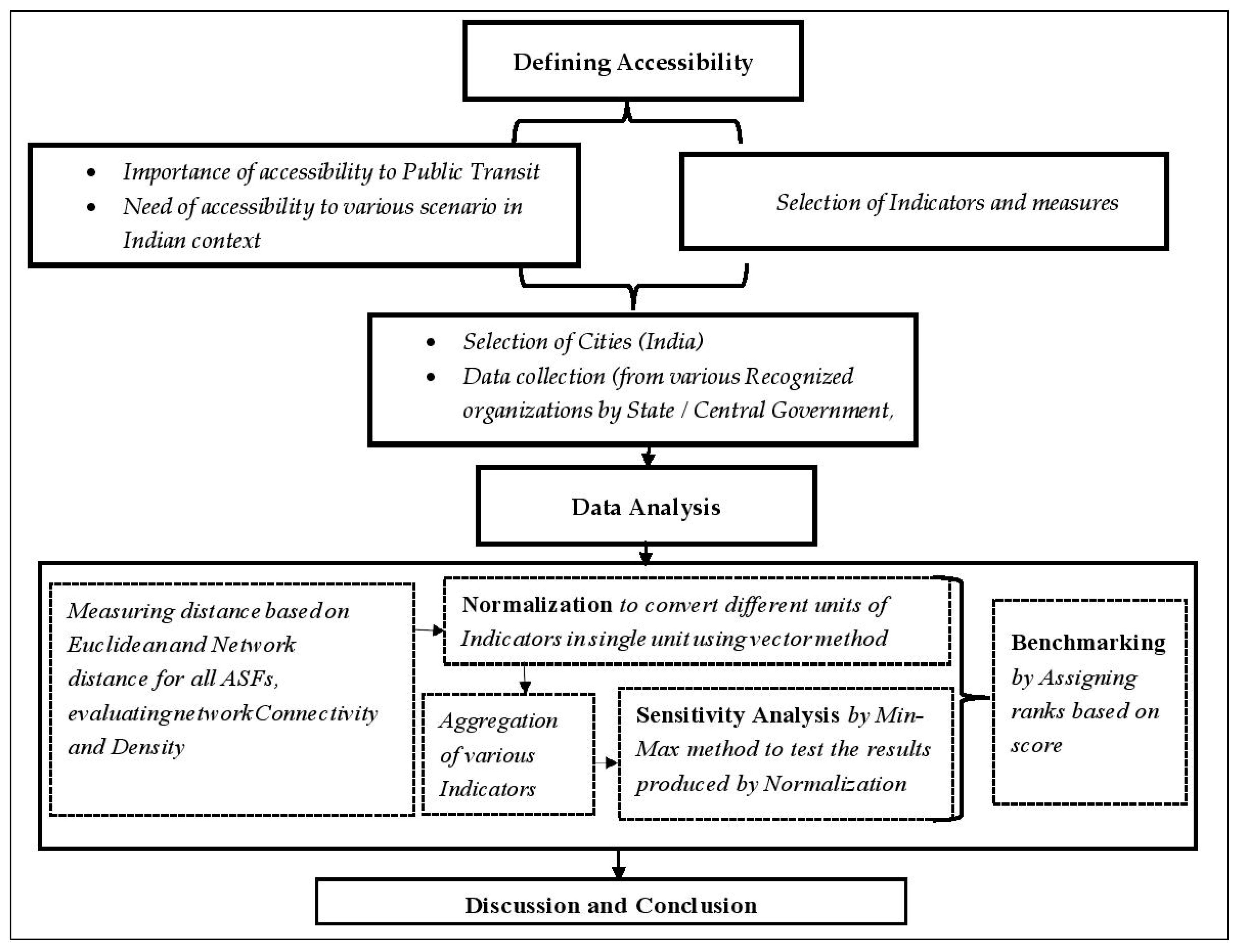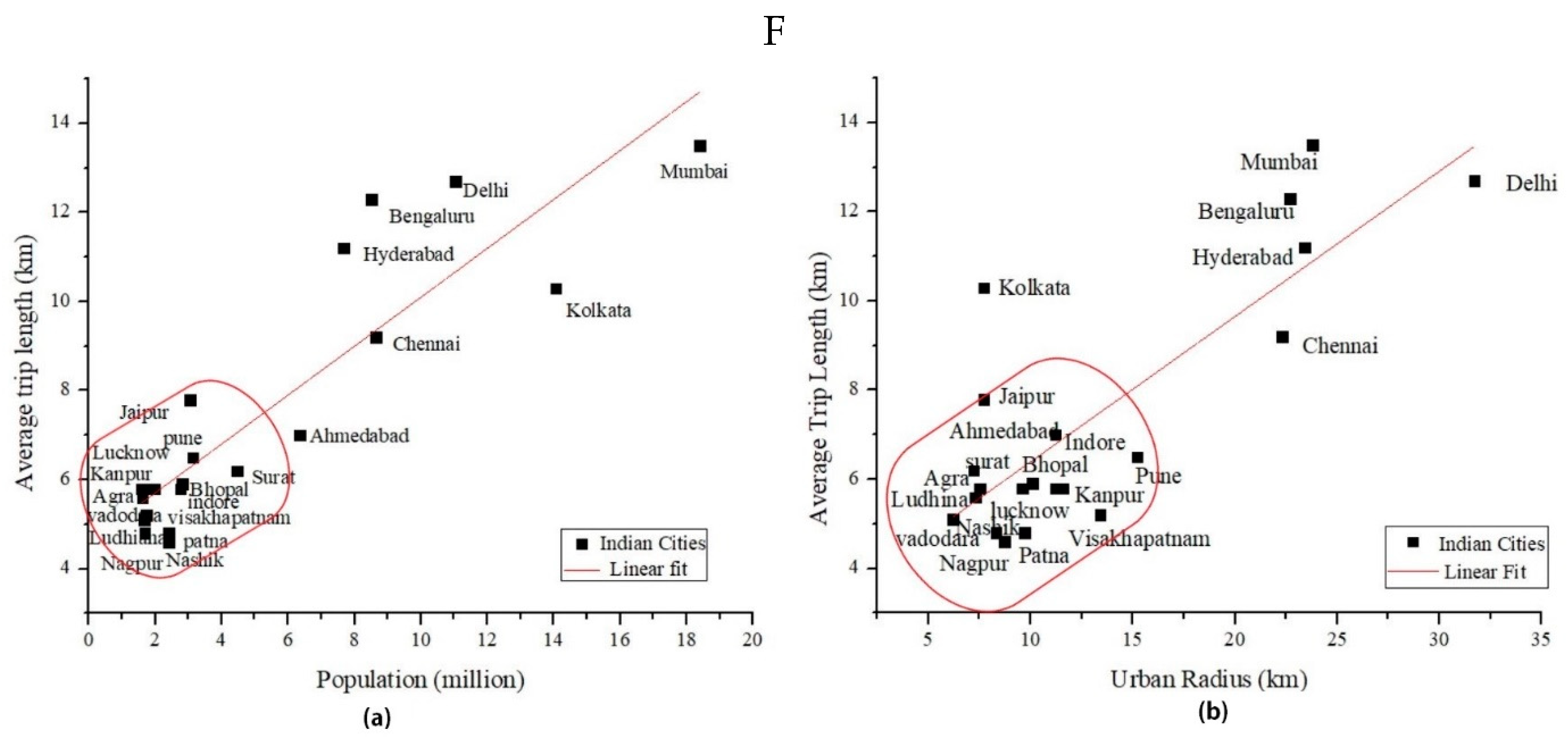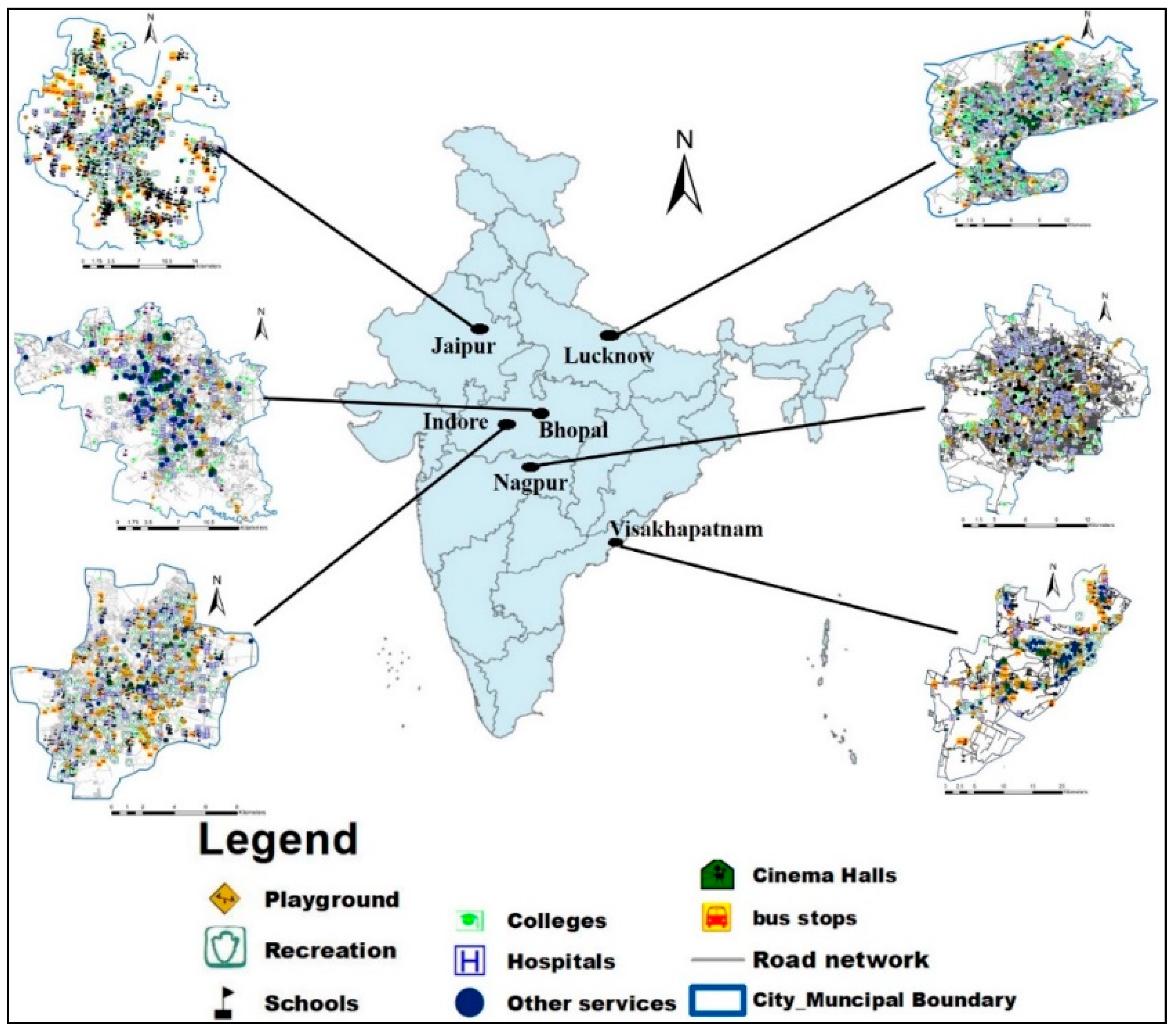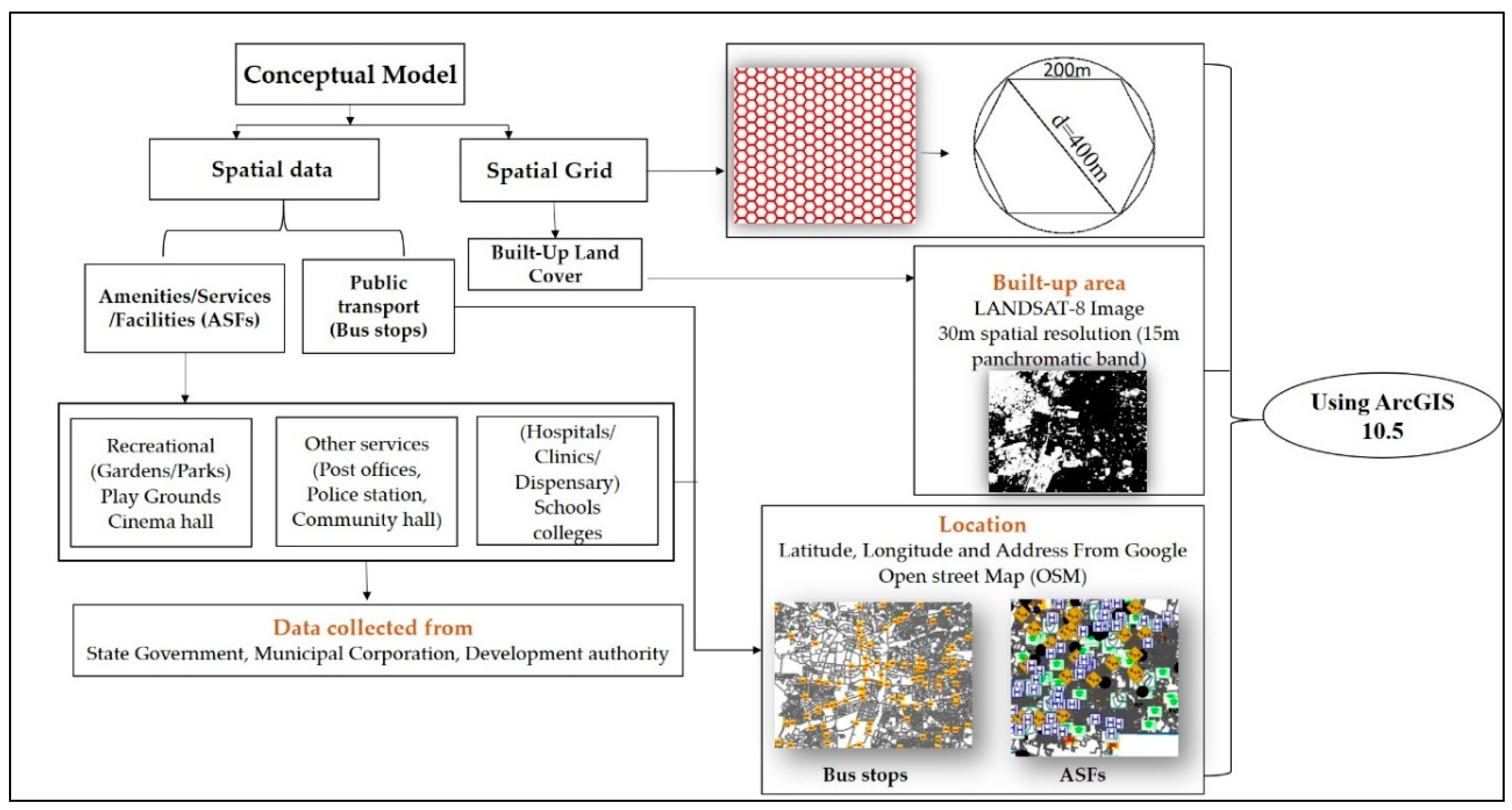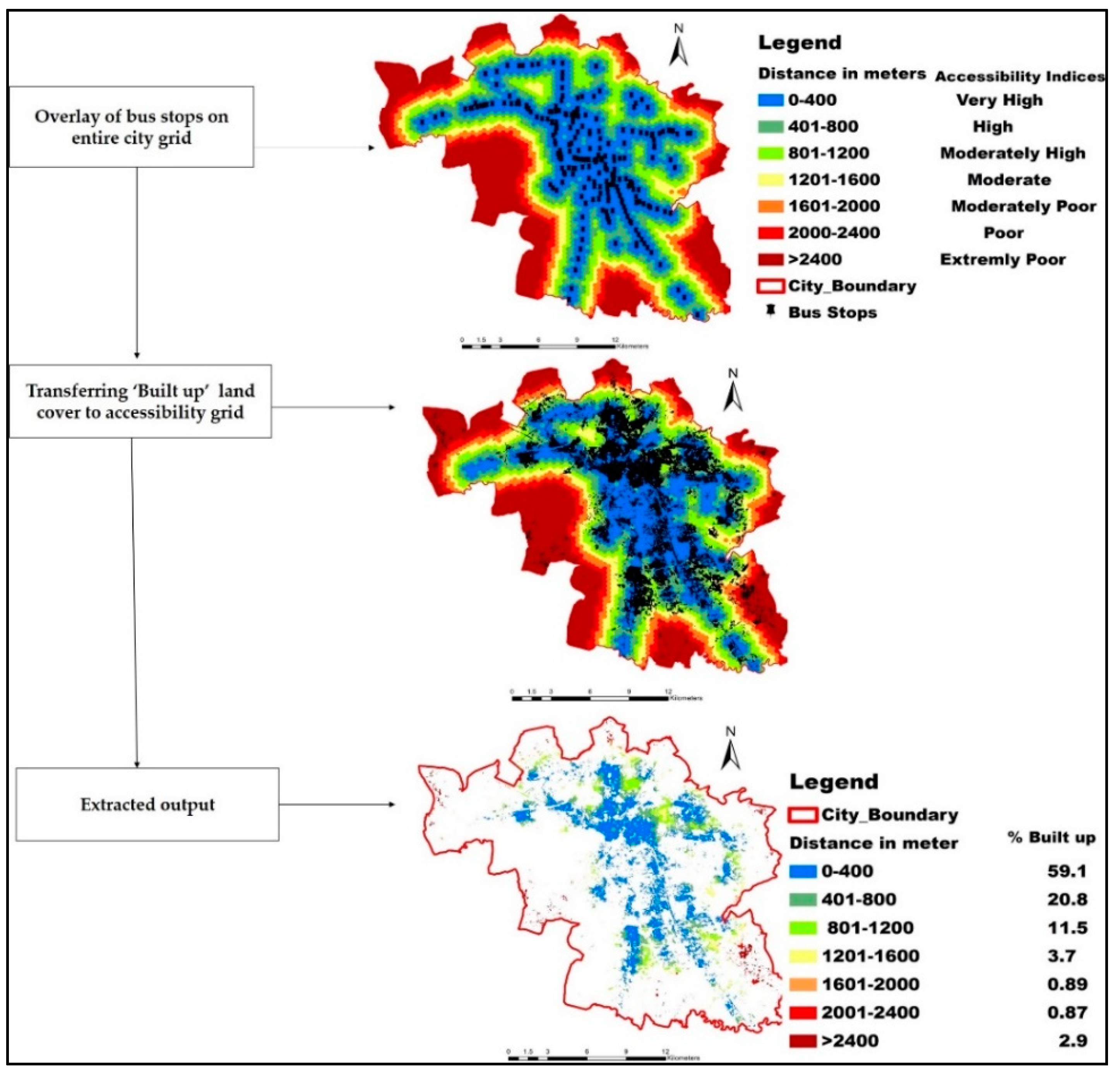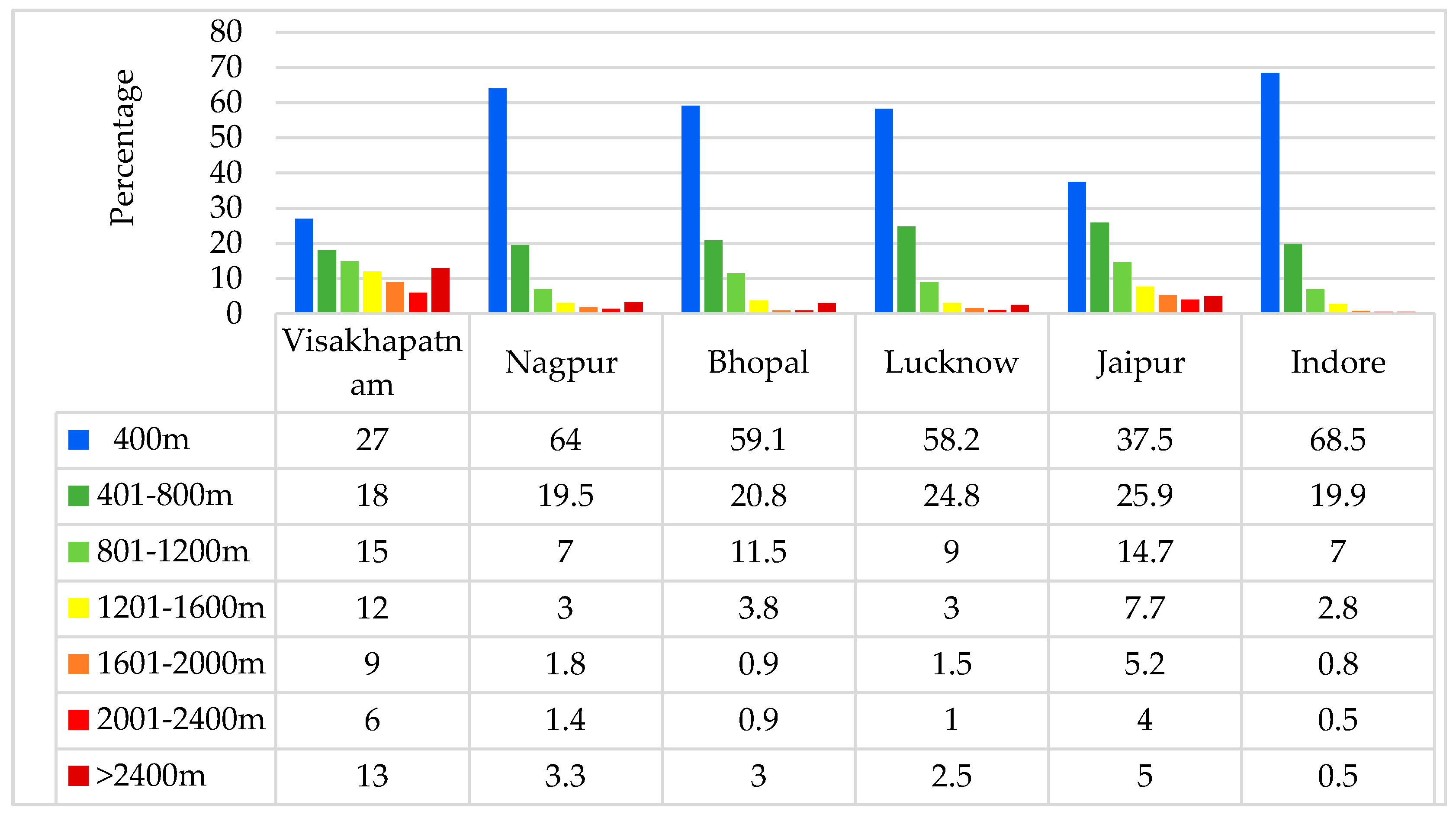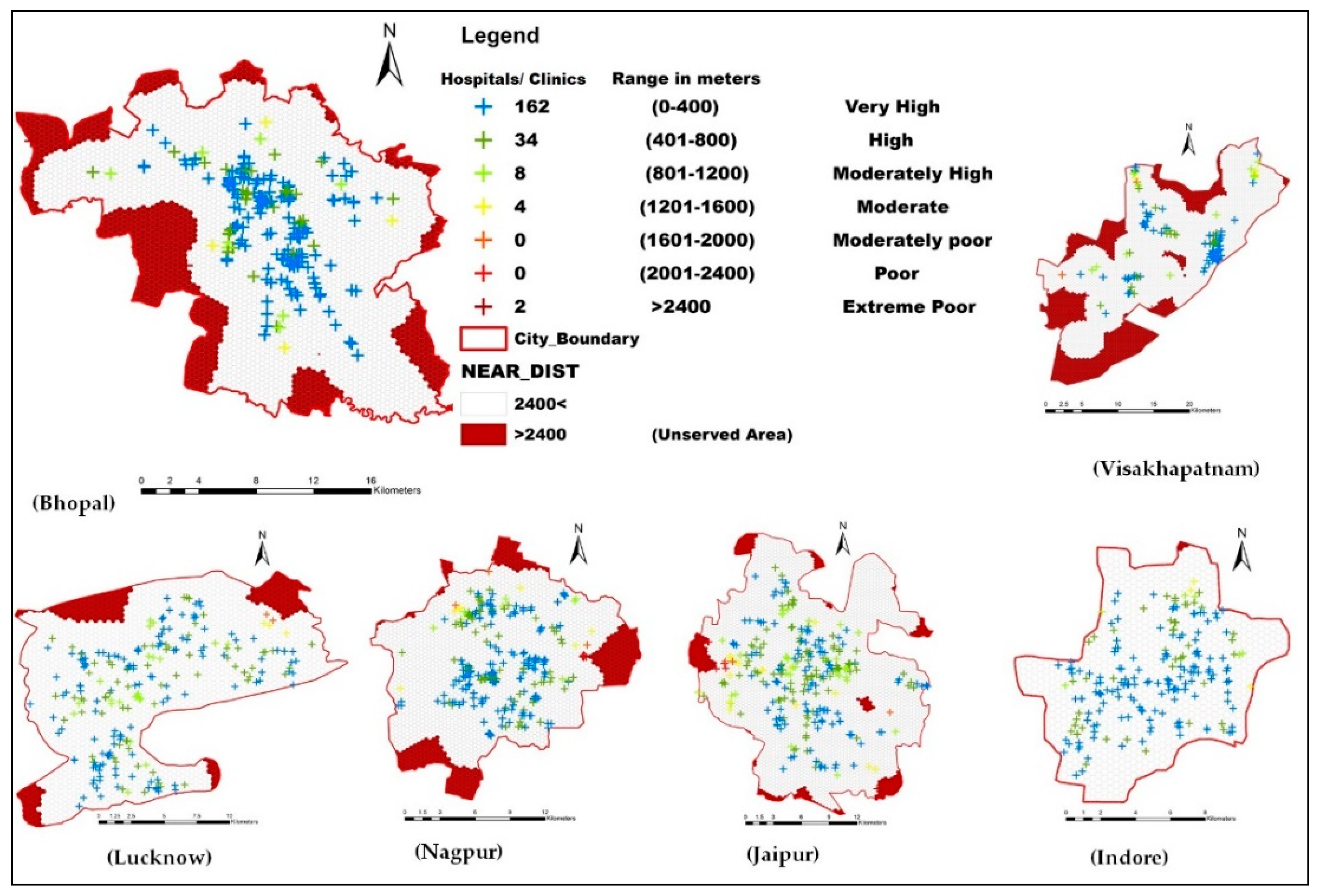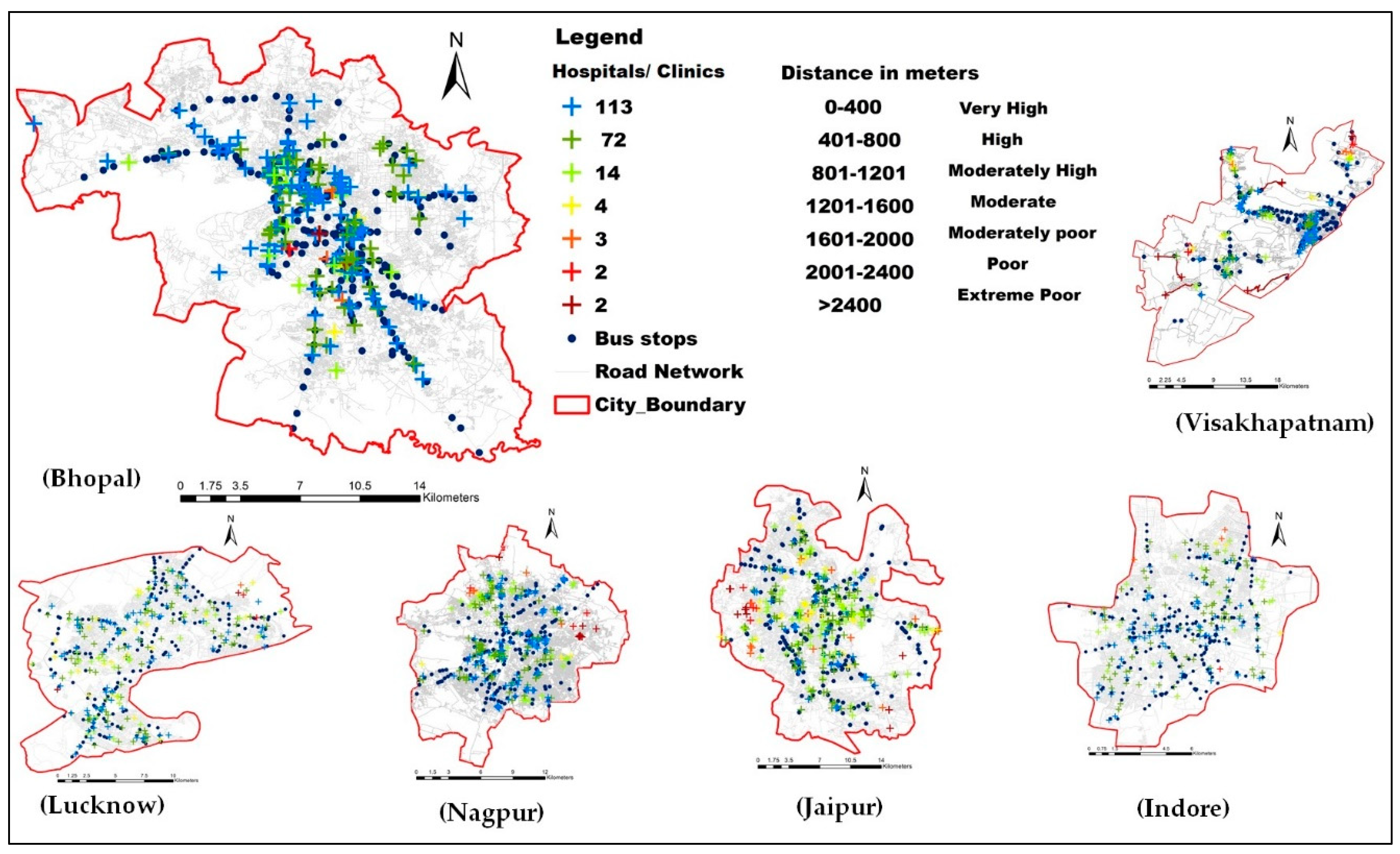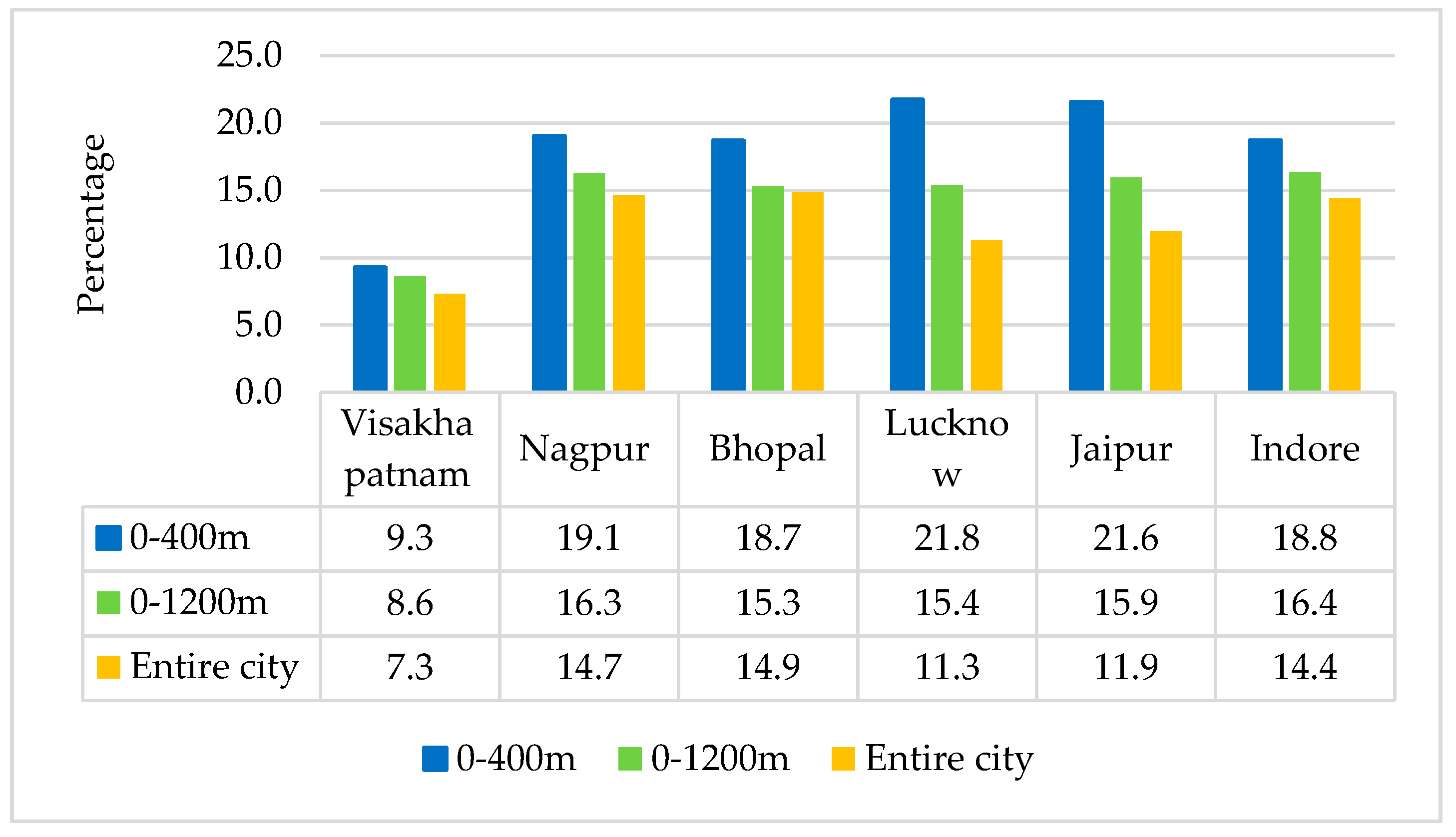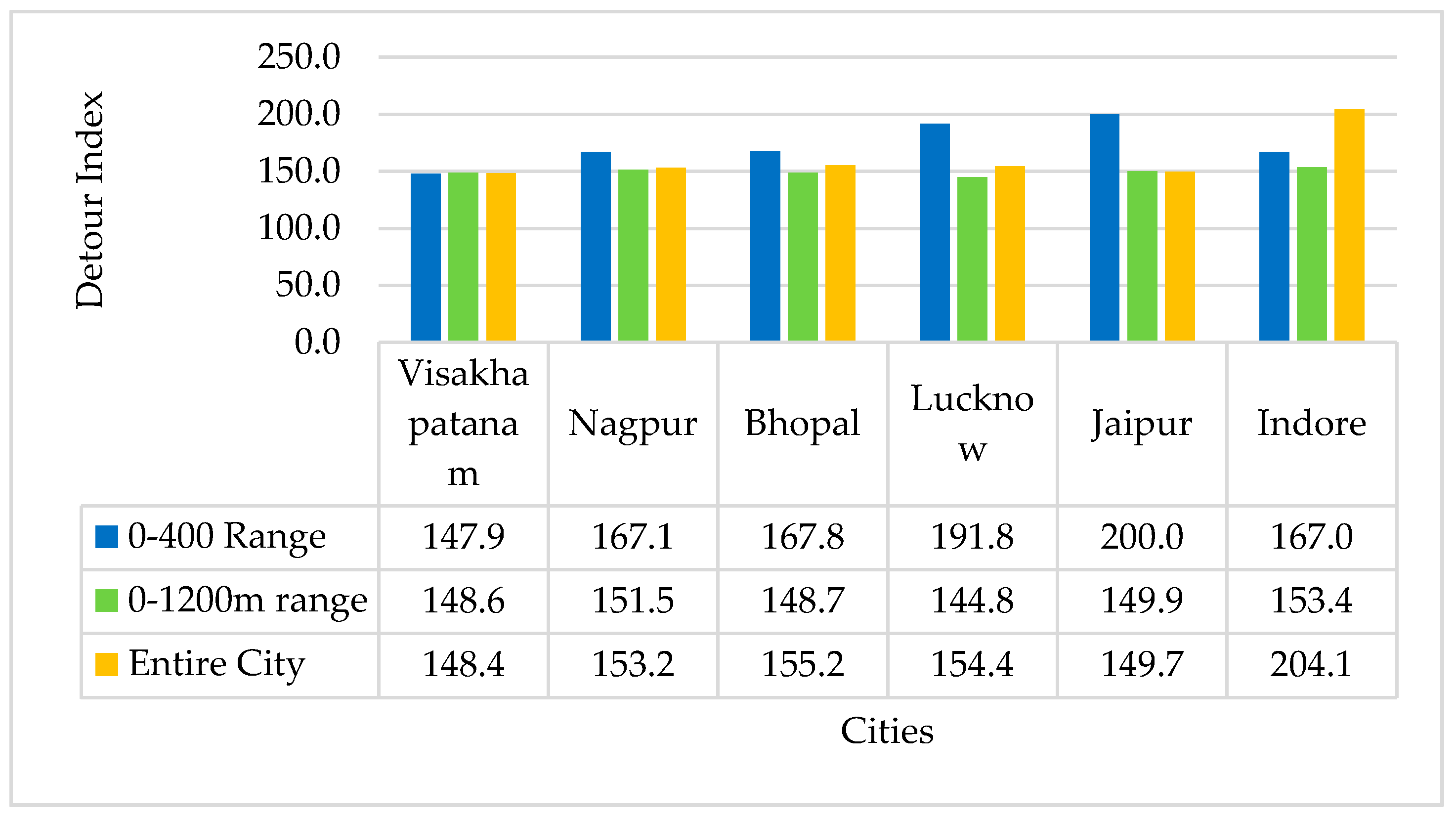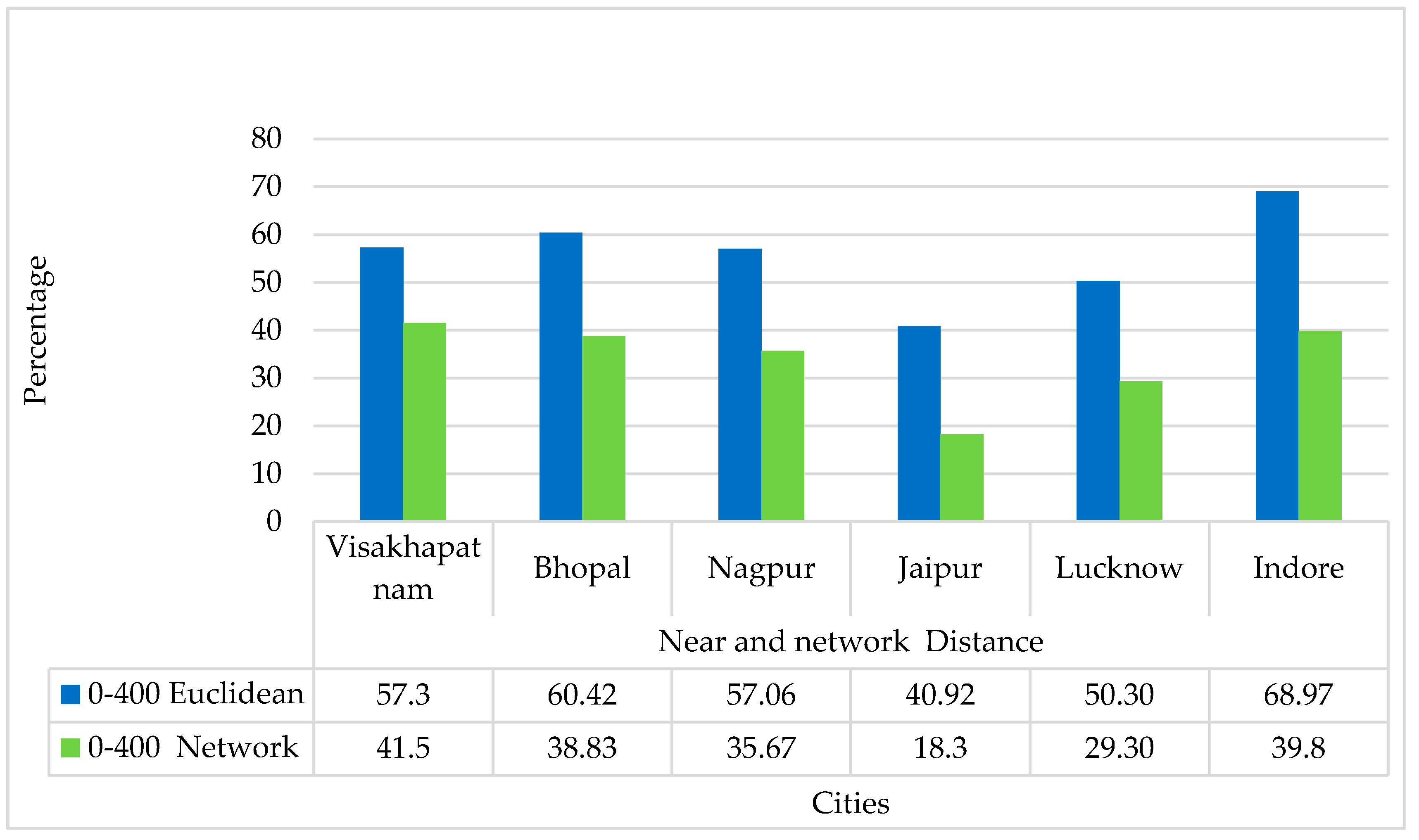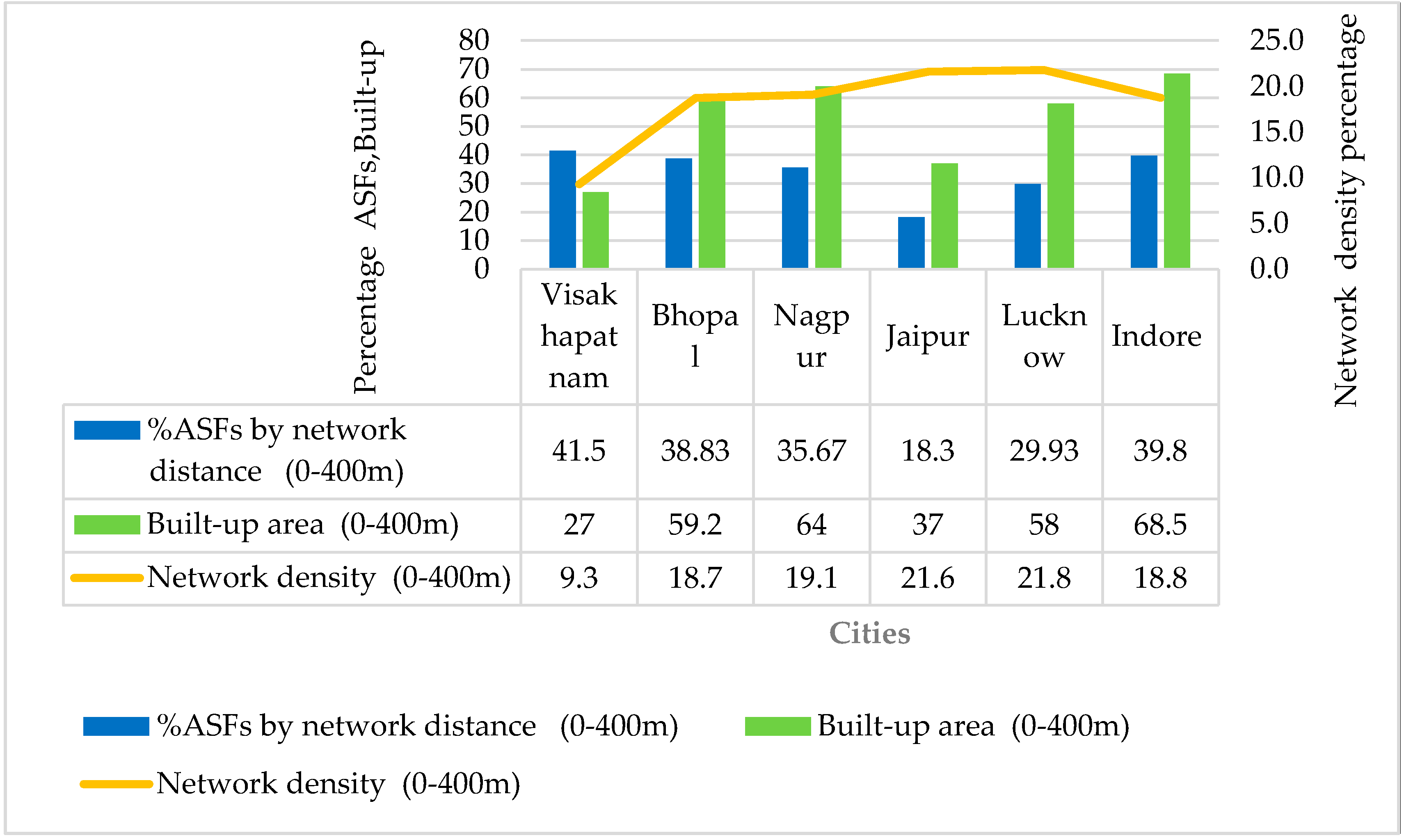1. Introduction
For the past five decades, accessibility has been central to physical planning and spatial modelling. Hansen (1959) defined accessibility as the ease of access to a desirable destination by linking land use and activities with the transport network [
1]. Later on, researchers called for a paradigm shift from auto mobility-oriented planning to accessibility-oriented planning [
2]. Evidence shows that better access to services by feasible modes with less impact on the environment is an influencing factor in achieving sustainable accessibility [
3].
In recent years, public transport has become increasingly focused on improvements in sustainability [
4]. Improving access to public transit (PT) can be considered as an effective way to reduce the external cost and negative impacts of motorized vehicles [
5]. Better access will encourage people to use more environment friendly transportation modes, including walking and cycling. These features that promote various forms of physical activity (such as walking) can be referred to as ’neighborhood walkability’ and they often consider destinations such as retail stores and parks, and community design features such as street connectivity and sidewalk access [
6,
7].
1.1. Need for Accessibility in Case of India
In India over a period of time, despite significant efforts to boost public transport growth in urban areas, the share of buses in total registered vehicles fell from 11.1% in 1951 to 1.1% in 2011 [
8]. Similarly, non-motorized transport (NMT) share has declined, and although walking and cycling still account for 33% in most Indian cities, the percentage is declining year after year. On the contrary, in developed nations, with leading examples from London, Berlin and Copenhagen, the renaissance of NMT is taking place, with shares of NMT of about 30% [
9]. Focusing on these incumbent issues, policies in India are now highlighting the opportunity to bring people and activities closer to PT [
10]; and even targeting the improvement of infrastructure for cycling, walking and the city’s overall network coverage [
11]. This will help in improving NMT infrastructure, thereby increasing access to various services to reach PT.
The distance that people walk to bus stops plays a crucial role in allowing the best use of public transport. The higher the percentage of people living or working close to the transit, the greater the probability of them using the service [
12]. Studies in developed nations are rapidly focusing on this issue, by measuring accessibility in various cities and metropolitan areas with spatial dimensions in reaching public transit using walk scores [
4,
13]. A few other studies on urban intervention for access to various kinds of facilities and services for walkable distances have compared cities globally, irrespective of their size [
14], and ranked them [
15]. Potential spatial accessibility measures evaluating distance to reach PT and other utility services have been little explored in cities in the Global South, especially in India. The pursuit of connecting various services and amenities to PT constitutes an important objective in recent planning in Indian cities.
Previous investigations of several studies of accessibility using geographical information system GIS were conducted at the city level, associated were dealing with accessibility to jobs, connections using public transport, reaching the nearest transit from workplace [
15,
16,
17]. But the focus on other amenities and services connecting to PT is very rare at the city level—these studies have so far focused on the neighborhood-level [
18]. Only a few studies have been conducted at the city level, such as the one conducted in Pune metropolitan area in India, which revealed that 41% of school children do not have access to public transit [
19]. Many students in India are restricted to their society schools because of inadequate PT services in some parts of the city, as lower-income families cannot afford private transport modes to reach schools at a far distance [
20]. Implementing geospatial technologies towards health access in numerous developed nations has become widespread, but the use of these approaches in India has been fairly slow [
21]. Only a small amount of research has been carried out in spatially connecting access to health care infrastructure with residents and the road network in India [
22].
There are many methods to measure cities’ accessibility, but they cannot be generalized for all cities and towns around the world, since accessibility is affected by the local network, data quality and local context [
23]. An alternative approach is needed to tackle unique and specific issues concerning settlements in India. Accessibility is well established at the neighborhood scale, but often a city is not a homogeneous entity in terms of dynamics, considering land-use patterns and network. In this study, a comprehensive cumulative accessibility score and index of cities is conducted. Additionally, spatial mapping of the city network and built-up area is taken into consideration, along with discrete interventions.
The present research is conducted in six Indian cities with a population of more than 1.5 million. Therefore, the scope of the present study is to assess the accessibility to various amenities, services, and facilities (ASFs) from PT at the city level and to explore whether the actual road network access (by measuring distance) in Indian cities is contributing to a high level of accessibility. The method in this study is more flexible and easier to use, and it helps to provide useful information for decision-making on improving accessibility to ASFs from PT. It also provides efficiency from a spatial perspective and thus assists policy makers.
1.2. Research Question and Hypothesis
Access to various services and amenities is recognized as an important facilitator and it becomes a primary concern in any accessibility plans. To integrate various services, geographic access plays an important role worldwide. In order to understand this importance, three research questions were studied: (1) what is the role of various indicators of spatial accessibility? (2) how can spatial accessibility in Indian cities be measured using combination of various indicators? and (3) how is accessibility between ASFs and PT measured? This study is an attempt to understand whether Indian cities have high access level, particularly in cities with a population of more than 1.5 million, i.e., million-plus cities in India. The components that relate to accessibility, such as built-up area and network density, were also included in this study. It is necessary to understand whether cities have better accessibility and whether the accessibility of ASFs to PT is high and can be measured at the entire city level. Indicators such as built-up area, network density and connectivity are combined to know the levels of cities’ accessibility. Two hypotheses were framed to identify levels of spatial accessibility based on distance criteria in the case of Indian cities: (1) distance of ASFs from PT plays a crucial role in defining cities accessibility. (2) Spatial accessibility in a city can be measured and evaluated based on various indicators.
This paper is organized into six parts—introduction, literature review, case selection and data collection, data analysis, results, discussions, and conclusions. The introduction presents the importance of accessibility planning and factors influencing accessibility. It further states the need to conduct the study in Indian cities for measuring accessibility, particularly to ASFs from PT. The second section describes the literature review by identifying various measures of accessibility with reference to cases of developed nations, which helps in the selection of indicators. The third section elaborates on the selection of cities and data collection. The fourth section presents the data analysis based on parameters including a data quality check, measuring accessibility by distance measures, detour index, normalization, etc. In the fifth and sixth sections, the results are presented, followed by a detailed discussion on the output of study. The last section makes the concluding remarks for the study.
2. Literature Review
There are various approaches for achieving sustainable urban development through a city’s form. One of the key aspects of sustainability focused on nowadays is accessibility, namely how accessible green spaces, jobs and services are to communities and how interconnected they are with walking and cycling facilities [
24]. Accessibility mostly depends on density and transport linkages, which in turn depend on land use distribution [
25]. It is necessary to develop accessibility for reasonable walking distance in cities of developing countries, because of a high level of mixed-use development patterns [
26]. Cities which are well designed allow people to have high levels of access to services and facilities, encouraging proximity and social interactions. This permits a range of public transport services and is less consumptive in terms of resource use per person [
27]. Evidence shows that better access to services by feasible public transport has a less negative impact on the environment [
3]. Therefore, the availability of public transport must be made close to the activities, whereby accessing them becomes much easier [
28]. Many cities concentrate on improving access to PT, which often involves some walking or cycling interventions to connect from the origin to destination of the trip, and this leads to improved last-mile connectivity [
29]. It interlinks the accessibility of one parameter to another, as shown in
Figure 1, for example improving accessibility towards walking and cycling to provide more local access. It will have a direct impact on public transport’s access and indirectly affects commuting distance for jobs, services, and recreation and health facilities. Overall, it requires policies for improving mobility with mode, road and pathway network, design and encouraging non-motorized vehicles in an urban area.
2.1. Measuring Accessibility: Methods and Techniques
Measuring accessibility is an essential component in many transport and accessibility plans, as it gives evidence for preparing guidelines and policies while also creating accessibility index [
30]. Accessibility measures often focus primarily on one specific mode or a limited set of destination types, such as jobs. Accessibility measures are classified based on two main aspects, i.e., travel behavior and potential availability of opportunities [
31]. These are divided into four important categories of active measures: (i) gravity-based, (ii) topology-based, (iii) distance-based, and (iv) utility-based [
32]. All these measures are now currently focusing on the growing interest in spatial data technologies and are expected to have many precise results [
33]. Studies are now widely carried out using geographical information system (GIS)-based mapping of accessibility to public transit [
13,
32,
34]. Moreover, studies focusing on access to health care and travel time to hospitals are now widespread, and the distance to shops and cultural facilities were found to be an important factor [
35].
Measures are described by a set of parameters concerning (1) a population-based spatial unit, (2) an accessibility measure, and (3) a distance measure chosen for measuring accessibility [
36]. While assessing geographic accessibility, the use of these criteria may produce different results depending on the distance measure selected. Some researchers explored the geographical accessibility of health facilities by calculating the accessibility to the nearest facility using the shortest Euclidean distance, (extension of Minkowski distance measures), network distance or a combination of distance types [
35,
36]. Whereas few studies used the choice of Manhattan distance and Euclidean distances [
37], but investigations later concluded that comparing Euclidean distance and network distance is more reliable [
38,
39]. Moreover, considering network distance measures further helps in the decision-making process for resource location and construction of new facilities [
40].
Furthermore, in various countries, accessibility is tested using multiple accessibility instruments (AI). One such is Spatial Network Analysis for Multimodal Urban Transport Systems (SNAMUTS) in Australia, where it uses geographical information systems (GIS) tools to assess the linkage between the public transport network by clustering land use and visualizing its strengths and weaknesses across the metropolitan areas by spatial mapping. Spatial Network Analysis of Public Transport Accessibility Systems (SNAPTA) in the United Kingdom contributes to identifying barriers and creates an accessibility index to integrate NMT with PT. It was developed with an idea to identify "whether, at a reasonable cost and with reasonable ease, one can reach to services and activities". A few studies, such as Isochrones Maps to Facilities (IMaFa) in Spain and Method for Arriving at Maximus Recommendable Size of Shopping Centre (MaReSi) in Norway, measure accessibility to activities such as shopping centres. The IMaFa tool calculates services in a buffer area using Euclidean distance and travel times along a network performed in GIS. MaReSi calculates services by using walking and bicycle distances from dwelling to shopping center within 1–2 km by road distance to the site [
41].
Land Use and Public Transport Accessibility Index (LUPTAI), developed in Australia, aims to quantify access by walking and the public transport network to destinations such as education, health shopping, jobs. LUPTAI considers walking in two ways: whether it is a single mode of access for a destination considering walking distances, i.e., (400, 600, 800, 1000 and 1200 m) or a mode of access to public transport i.e., (0–20, 20–40 and 40 plus min) [
42]. Tools like Walk Score
® (
www.walkscore.com) developed in the U.S.A tests access to the nearest public transit and services such as shopping and educational resources (schools and libraries) by walk scores and this tool is available in the public domain [
6]. All these instruments are known for interventions that cover the aspects of physical distance, travel time and travel cost.
By comparing all these AI tools irrespective of their strength and weakness, a study showed that instruments using spatial separation measured by an existing network rather than gravity measures have a high level of communication value on ground level, meaning that even non-expert users can easily interpret network flows or link connectivity [
43]. Therefore, the presented study adopts spatial accessibility measures used by researchers in the past [
36,
37,
44]. However, these studies have not often been conducted in developing nations like India. Hence, there is little quantitative work on the accessibility of Indian cites done previously. This study uses spatial data for developing an index to compare accessibility in Indian cities, by excluding cost and time factors, as they create complexity for comparing various cities. Here, the distance from ASFs is investigated using both Euclidean and network distance, and we compare both techniques within and among the cities in the Indian context.
2.2. Selection of Indicators
In a few studies, the macro-scale evaluation considered land use and land cover, job density and population density [
44,
45]. However, Indian demographic information corresponds to the 2011 census, and authoritarian land use plans are more than a decade old. This study, therefore, only includes built-up area extracted from Landsat 8 images, and thus the ASFs mapped are from year 2018–2019.
A comprehensive spatial accessibility assessment would help policymakers to take appropriate actions for improving overall accessibility in cities. Relevant indicators are selected from various literature regarding mobility/walkability [
46,
47,
48], for land cover [
49], and for network density, connectivity [
50,
51], as shown in
Table 1.
The selection of diverse and multifold opportunities will provide a viable option to assess accessibility plans in a much better way. Education, health care, leisure, entertainment activities, and commuting capabilities are commonly seen as the leading demands of urban contemporary life. Unlike economic development infrastructures, social infrastructure includes the facilities and places that primarily serve the specific needs of everyday life [
52]. With this understanding, various utilities in developed nations were identified as relating to accessibility to a specific infrastructure, such as health [
39,
52], parks and green spaces [
38,
53], schools [
54,
55], transit [
32,
56,
57,
58]. A common goal for these studies was to limit the usage of private vehicles and encourage access to public transit by walking and bicycling. Based on this, various sectors are categorized as ASFs (
Table 2). In India, as per guidelines, policies and a few research studies have identified recreation activities as “Amenities” in the urban local bodies act, (Government of India, 1992) [
59], while police stations and post offices are considered in the category of "Services" [
60]. Education and health are considered in the category of "Facilities" in the 83rd Constitutional Amendment Act (Government of India, 2002), which focuses on universal access [
61].
2.3. Identifying Reliable Walking Distance
To measure accessibility using distance, researchers used standard walking distances similar to the planners’ thumb rule, i.e., 400 and 800 m [
62,
63]. Even the World Bank suggests that bus services should be made available for less than 400 m distance to encourage pedestrians [
64]. A few other recommended distances from different literature reviews are shown in
Table 3.
Indian policies which encourage accessibility specify ideal distances to access urban facilities and services. The Urban and Regional Development Plans Formulation and Implementation-2015 (URDPFI) guidelines [
72] dictate that the ideal distance for facilities and transit must be available within 600 to 800 m. The colour code used for mapping and identifying Euclidean and network distances is shown in
Table 4.
5. Results
The outcomes drawn from the analysis are put into two stages. Initially, in the first stage, the study compares the difference between the Euclidean and network distance for all ASFs from bus stops by evaluating it for all six cities. The first stage includes four assessment criteria—(i) the percentage of ASFs available within the various range of distances 0–400, 401–800 and 801–1200 m, (ii) correlation between Euclidean and network distances for entire city, (iii) mean of Euclidean and network distances for entire city, (iv) difference between Euclidean and network distances within various range of distances for ASFs sector-wise (0–400, 401–800, 801–1200 m). In the second stage, the discussion is carried out by relating the criteria (v) built-up area, network connectivity, network density with the percentage of ASFs in the range of 0–400 m, and the detour index. Finally, (vi) normalization is done by merging the results of the two stages.
- (i)
The percentage of ASFs available within a various range of distances, 0–400, 401–800 and 801–1200 m
The comparison between Euclidean and network distance (0–400 m) for very high-level ASFs is shown in
Figure 14. The result shows 50% to 69% of combined ASFs are easily accessible through Euclidean distance of 0–400 m range, but through network distance, the combined ASFs percentage for the same range is nearly half of the Euclidean distance in all the six cities. This observation suggests the presence of local natural and humanmade physical barriers; undesirable location of bus stops and bus routes; and network issues, which tend to increase the distance and lower the accessibility to ASFs.
The percentage of ASFs across the identified individual sectors (example hospital and clinics) is observed by comparing
Table 7 with
Table 9 for the (0–400 m) very high accessible range. In Visakhapatnam city, for hospitals and clinics, the low difference (9.77%) between Euclidean and network distance indicates high accessibility by using the network. In Nagpur city, for playgrounds the high difference (26.31%) between Euclidean and network distance indicates low accessibility by using network in 0–400 m range. For other services, the percentage difference is 44.44% between Euclidean and network at a 0–400 m range which is high when compared to other sectors in Bhopal city.
The results from
Table 8 and
Table 10 are compared for the range of 0–400 m combined ASFs. It is observed that Indore city is having the highest percentage by Euclidean distance while Jaipur city is having the lowest. This scenario is entirely different in case of network distance, where almost 30% of combined ASFs are inaccessible in the case of Indore city as shown in
Figure 14. It is observed that almost 70% of combined ASFs are accessible within 1200 m range of network in all the cities (
Table 10). Above all, hospitals and clinics, other services have high accessibility to bus stops in all the cities in the range of 0–400 m compared to the rest of the ASFs through Euclidean as well as network distance.
- (ii)
Correlation between Euclidean and network distance
The overall Euclidean and network distance correlation is performed for entire ASFs in all the cities using Pearson’s correlation method to find the relationship. First, evidence shows high correlation at very similar rates in all the cities except Indore city as shown in
Table A3 in
Appendix A. It has been verified at a 0.01 (2-tailed) significant level. Since, the R
2 variance only shows the relationship between Euclidean and network distance, hence descriptive statistics analysis is performed to identify the difference between Euclidean and network distances in meters.
- (iii)
Mean of Euclidean and network distance
Descriptive statistics are performed in the Social Sciences Statistical Package (SPSS 16.0) for the selected six cities, and the combined mean average of ASFs for every city is given in
Table 12. It provides scope for identifying the average difference in the city. The difference is very less in Nagpur city with 212.4m compared to other cities while it was higher in Jaipur city.
- (iv)
Difference between Euclidean and network distances within various range of distances for ASFs sector-wise (0–400, 401–800, 801–1200 m)
The correlation, mean difference between Euclidean and network distance for ASFs were observed, as they influence the identification of network connections in the city for reaching bus stops. While considering the entire city, high correlations were found among all the cities as shown in
Table 11. Now, by considering it for different threshold ranges 0–400, 401–800, 801–1200 m for ASFs by sector wise in all the six cities, as shown in
Table A4 in
Appendix A. For the range 0-400 m, the observed correlation is 0.02 to 0.86,
p < 0.001, for 401–800 it is 0.09 to 0.79,
p < 0.001; and for 801–1200 m it is 0.25 to 0.91,
p < 0.001. These values show significant correlations when comparing all sectors of ASFs, and the range varies as high as R
2 = 0.91 and as low as R
2 = 0.02 in all the six cities. Even in this case, very low correlation is observed in Indore city compared to the other five cities. The average difference between the Euclidean and network distances within each range in all six cities is as high as 50% in each sector for all ASFs. The resultant difference between Euclidean and network distances vary which is very logical as it is based on ground reality.
- (v)
Relating built-up area, network connectivity and network density with a percentage of AFSs in 0–400 m range:
The relationship between built-up and network connectivity and density is one of the important characteristics for identifying the city’s accessibility [
56]. In all six cities, as shown in
Figure 15, it is observed that Indore city has the highest built-up area percentage and Visakhapatnam city has the lowest.
Despite less network density and built-up area, Visakhapatnam city has the highest percentage of combined ASFs accessible using network distance from bus stops compared to other five cities. ASFs are accessible using network distance from bus stops. In the case of Jaipur city, even though it has both high network density and better connectivity, as shown in
Table 11 but has a low percentage of combined ASFs present in this range which in turn affects accessibility. For Lucknow city, the network density is very high compared to the other five cities.
Visakhapatnam has the lowest detour index for all combined ASFs 0–400 m range of accessibility, as well as for the entire city network, shown in
Figure 13. The length of edges within the road network connecting bus stops from ASFs is lower compared to the rest of the cities. While it is upturned in the case of the city of Jaipur, where the edge length is 0–400 m high. In the case of Indore, the detour index is very high, which indicates that the edge length is substantially large in the city connecting bus stops from all combined ASFs compared to rest of the city. It is evident from the findings that a few cities are strong in one dimension and weak in another. To generate consistent results from the different analyses, normalization is done.
- (vi)
Results of Normalization and Sensitivity analysis
The results of Euclidean and network distances are separately evaluated, and ranks were given to the cities accordingly. The performance was evaluated for the high range of accessibility considering 0–400 m and 0–1200 m for both Euclidean and network distance. For Euclidean distance, the percentage of ASFs accessible (
Table 7), built-up area (
Figure 8) and the average distance from
Appendix A Table A4 were considered and normalized as shown in
Table 13 and
Table 14. Similarly, for network distance, percentage ASFs accessible (
Table 10), network connectivity (
Table 11) and the average distance from
Appendix A Table A4 were considered and normalized and the results are shown in
Table 15 and
Table 16.
The results of vector method are compared to the minimum-maximum method for the same indicators as those produced by vector method from
Table 13. By rearranging them rank wise, it is observed that scores of both ways vary, but the order of ranks was quite similar, as shown in
Table 17. In the vector method, the division of metric units is more precise compared to min-max method.
From the overall results of normalization, it is observed that within 0–400 m and 0–1200 m range of Euclidean distance, Indore city ranks first compared to other cities, as shown in
Table 13. However, when considered through the network distance, it is ranked lower. When considered through the network distance, Bhopal city ranks first for network connectivity, and the mean distance to reach ASFs from bus stops is high. In the case of Visakhapatnam city for Euclidean distance, it is poorer because the built-up area is very low in the 0–400 m range. However, when compared by network distance, it ranks second. This is because a large amount of combined ASFs are accessible in this range refer (
Table 10) compared to cities of Lucknow, Jaipur, and Indore.
6. Discussions
In this section, the choice of apt indicators to measure accessibility is discussed elaborately. The distance approaches used to evaluate accessibility levels and the ranking of the cities are considered in the following section. Limitations and data constraints for the present study are debated. Overall, how the results can be applied for planning is discussed in detail as follows:
- (i)
Choice of indicators and methodological concerns
The prime focus is the selection of the most appropriate indicators for defining the accessibility to ASFs from PT. This may depend on several factors, such as the aim of the research or application, the number, and types of data available, the methodological assumptions and the choices (type of distance) made. The evaluation of ASFs is performed as the study aims to understand variation in accessibility in various cities from PT, and particularly which ASFs (such as hospitals and clinics) are more accessible
Using simple distance measures such as Euclidean and network may be most appropriate [
38], as they are localized and easy to evaluate ASFs from PT. The choice of built-up area for evaluating the distance in this study becomes crucial for identifying geo-located features and labels. It acts as a background to categorize levels of accessibility as per distance using the grid-based method. In several developed nations, the importance of accessibility instruments in planning practice has increased [
41]. But with developing nations, this is still in the commencement stage. However, nowadays, availability of data in OSM has facilitated GIS implementation with the transport module (e.g., ESRI Network Analyst Extension) [
39]. The possibility of focusing on city level accessibility using various parameters for spatial assessment in this research became easier in comparing various cities. Hence, the assumption made in the hypothesis was proved, as this study consists of various indicators (based on physical elements such as built up, connectivity and density of ASFs). Although the accessibility of each ASFs differs, grouping as per various accessibility level by evaluating combination of influencing indicators, various scores and ranks are assigned.
- (ii)
The distance approaches
Euclidean distances are easy to measure in ArcGIS 10.5.1 software and are used in planning applications traditionally [
39]. They do not need a network street layer when measuring the distance between ASFs and PT. However, while measuring by network measures, some additional work is normally needed when setting, such as manually snapping points to the network. Euclidean distances do not adequately represent the actual distances. Accessibility can be measured by different methods as discussed in the literature but measuring accessibility by network distance method is an essential tool for any study and at any scale (city, area and neighborhoods) as it focuses on ground reality [
48]. This helps to identify the problems at a deeper level, making it easier for both municipal and local authorities to provide recommendations for improvement in preparing a master or regional plan. The network distances used are more accurate and closer to the actual distances. Since they are calculated using road segments, they represent the actual distances that the user has to walk/drive to reach ASFs, which is very well understood from the literature [
40]. However, network distances could minimize this effect because, when generating the network in the ArcGIS 10.5.1, ASFs centroids are moved to the nearest element of the street network before the distance is calculated. Although there may be opportunities to use network distance and accessibility points, researchers may prefer Euclidean distance to reduce computation time, when accessibility measures are considered if there is no availability of accurate network data.
- (iii)
Limitations and data constraints
Data in research play an enormous role while choosing elements for assessment usability, mentioned in the literature analysis, this study uses secondary data. In such cases, there is no choice but to use what one has. However, the quality and accuracy of the data are determined. In all the cities, indicators were measured within the municipal area. Since no spatial data of ASFs outside the city are considered; for this reason, the ’border effect’ may exist and influence the result of Euclidean and network distances which is reported by similar studies of Apparicio [
36,
37].
- (iv)
Implications of results in planning
The findings of this study encourage that almost 70% of ASFs are present within 1200 m of bus stops through network distance in all the six cities. However, it is also suggested to increase density of the ASF’s within 400 m in areas nearer to bus stops. This will lead to a higher percentage of ridership by bus. The method of statistical assessment to perform linear regression is easy to understand. The analysis shows a significant correlation for various indicators. In particular, a strong correlation has been found between indicators measured with Euclidean and network distances at the entire overall city level (higher than 0.55, p < 0.001) in all the cities. Significant spatial variations in geographical accessibility were observed across six cities. The analysis demonstrates that regardless of the usage of travel mode and population density, the majority of ASFs in the cities of Lucknow and Jaipur have low access to PT through network distance. Meanwhile, it is high in cities of Visakhapatnam and Indore which is significantly different from results of Euclidean distance. Moreover, the entire data are represented in percentages, which helps in decision making and can be used in further studies that encourage public transportation, NMT infrastructure and high priority bus lanes. The red colour marked on grids and network maps stands out as a challenge, showing the implementation of upcoming bus stops in the future.
There is an uneven distribution of ASFs, where most are concentrated only at the center of the city like for Visakhapatnam. This hampers the availability of the nearest bus stop to a few ASFs at other locations, particularly in newly developed areas. Consideration of built-up area and network density will help to improve the number of additional ASFs within the high access level that are closer to the bus stops and targets in improving the network condition where development would occur in the future. This is provided by the spatial metrics studied in this research.
The location of bus stops used to assess the reliability of bus services have a direct impact on the performance of the transit system and services. However, this study does not evaluate errors in the choice of distance types with aggregation method [
36], cost and time [
58], and population [
38]. Such limited exactitudes could be combined for future studies to automate demand-based bus stop locations which emphasize land use distribution and demand for the service. The results suggest policy and design implications in all the six cities, such that in the initial stage, new regulations of existing guidelines must be implemented at the policy level. The upcoming infrastructure of ASFs must be planned as per consideration by measuring the distance to any nearest PT. Pedestrian planning guidelines in Indian code IRC: 103-2012 should be revised to include distance factor along with the quality of pedestrian infrastructure [
95]. The new network should be planned by providing a more significant number of links connecting the nodes. Comparing cities develops a common framework to identify the level of access to each town and issues in those cities [
9]. Application of this kind in similar studies will help in comparing cities with benchmarked cities globally and will surely pave a new way. This study focuses on city level assessment, due to its scale/density of activities, it will further hamper the accessibility of the city in future. The ranks are assigned to understand the position of the city by comparing its performance with other cities and to compete to stand as a benchmark and become a target for other cities to achieve and improve PT. Summarizing the nature of ranking in this study shows city of Bhopal, Indore, Visakhapatnam has high rank which stands out as a benchmark, whereas Nagpur, Jaipur, and Lucknow scores low rank for network distance 0–400 m range. In general, the higher the rank, the better it encourages accessibility for ASFs from bus stops.
7. Conclusions
The study adopts a unique approach as it integrates several ASFs and evaluates spatial geographic access to ASFs from bus stops by using both Euclidean and network distance measures in six Indian cities. The study tries to identify the level of accessibility to every ASFs sector-wise connecting the bus stops. Some ASFs from a place of residence may have high accessibility at the neighborhood level but still they do not have a decent bus stop connectivity. Sometimes, people going to the nearest ASFs in a neighborhood may be debated, as they may prefer to move to other ASFs further from home. This study considers the links for the walkable distance between bus stops and ASFs to encourage people to use public transport. The grid map overlapped with the built-up area helps in identifying areas with no transit at all and areas with only a few bus stops. The present work proposes and discusses a set of indicators that can be used in urban planning further. Measures are divided into two major categories: Euclidean and network. First accounts using straight line distance while the second calculates distance by using road network. More precise and accurate results are obtained when using network distance, although using network distance requires more data and analysis (e.g., a network layer). The results obtained by using Euclidean distance overestimate the distance. The results of this research indicate the necessity of land use planning by increasing the density of ASFs in areas close to bus stops, concentrated within 400 m of transit, which in turn leads to a higher percentage of ridership by bus.
In India, current policies on accessibility target on building up new infrastructure, but they do not define how accessibility is achieved in cities and assessment measures required for accessibility planning. In this research, various ASFs are identified based on levels of accessibility and combined with other indicators for ranking. Overall, the percentages at various levels and scores can be considered for further studies and will help researchers and planners in terms of the methodologies used, accepted assumptions, and limitations.
In any context, indicators used for the assessment of the accessibility of ASFs from PT represent very important tool for planning of urban areas in India. They may provide a framework for developing different public transit policies in municipalities and in metropolitan areas (regions, metropolitan areas).
Further research might include the refinement and addition of indicators so that they can further strengthen the integration of various land uses connecting to PT with relevant factors that affect accessibility. A similar methodology can also be adopted in other cities in India for evaluating accessibility. This research explores the possibility of including some of the factors such as slope, elevation and road condition that affects accessibility to reach PT irrespective of shortest distance. These methods can be further applied to other transit such as metros in future, as the choice of origins and destinations may influence interpretation differently for a city.
